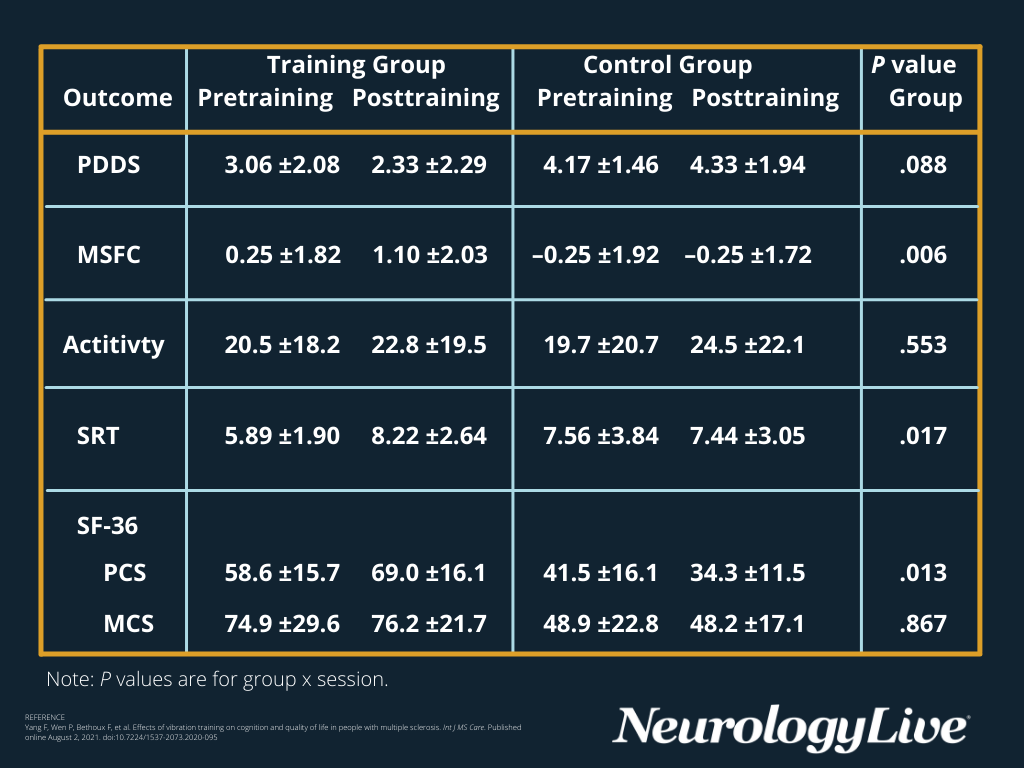Article
Vibration Therapy Effective, Well-Tolerated in Patients With Multiple Sclerosis
Author(s):
Investigators used statistical analysis to evaluate the effectiveness of the treatment method, with results indicating it could be a viable method for patients with MS.
Feng Yang, PhD

Investigators of a recent study found the use of vibration therapy could be effective in improving cognition, disability status, and quality of life (QOL) for patients with multiple sclerosis (MS).
A total of 18 adults with MS were randomized into treatment and control groups, with those in the treatment group (n = 9) undergoing 18 sessions of vibration training over the course of 6 weeks. Those in the control group (n = 9) did not undergo any vibration training and were instructed to continue life normally. Patients who underwent vibration therapy finished all 18 sessions and 2 assessment sessions, reporting no serious adverse events (AEs).
Using a statistical analysis, investigators collected data on three outcome measurements (cognition, disability, and QOL), each analyzed using generalize estimating equations (GEE). In the event of significant group-session interaction, a post hoc analysis was performed.
“It has been suggested that vibration training could be an effective training modality, producing effects similar to resistance (i.e., strengthening muscles) and aerobic exercise (i.e., enhancing cardiorespiratory fitness). Increasing evidence confirms that physical activity delays disease progression in people with MS,” Feng Yang, PhD, associate professor, department of kinesiology and health, Georgia State University, et al wrote. “Previous studies documented that both resistance and aerobic training have the potential to mitigate disability level in people with MS. Because vibration training is a physical exercise modality, it could alter the level of disability in people with MS. The present findings augment our understanding of the effect of exercise-based training, in particular vibration training, on improving the disability level in people with MS.”
READ MORE: Associations Between Contrast-Enhancing Lesions and MS Disease Spectrums Raise Questions
When evaluating disability status, investigators found no significant difference in Patient-Determined Disease Steps (PDDS) scale scores for group (P = .062), session (P = .287) and group-session interaction (P = .088). While Multiple Sclerosis Functional Composite (MSFC) score showed a significant effect for session (P = .007) and group-session interaction (P = .006), there was no main effect for group (P = .600). A post hoc analysis showed significant increase in MSFC within the training group (P = .006), but not the control group, from pretraining to posttraining assessment sessions (TABLE).
TABLE. Between-Group Comparisons.
Click to enlarge.

Patients were evaluated for disability status via the PDDS scale and MSFC, cognitive function was evaluated via the Behavior Rating Inventory of Executive Function–Adult Version (BRIEF-A), and the Selective Reminding Test (SRT), and QOL was evaluated via the 36-item Short Form Health Survey (SF-36). Compared to patients with MS who did not undergo vibration therapy, patients in the training group showed greater improvements in MSFC score, the metacognition index (MI) score of the BRIEF-A, SRT score, and physical domain score of the SF-36.
When evaluating executive function in daily living via the BRIEF-A, a post hoc analysis found that the training group had a significantly lower MI than the control group (P = .021) and from pretraining to posttraining, the training group demonstrated a significant reduction in MI (P = .045). No significant effects were observed in the Behavioral Regulation Index (BRI) or the Global Executive Composite (GEC). However, initial analyses of MI scores did show significant group-session interaction (P = .049), while group and session were nonsignificant.
Those receiving vibration therapy saw significant improvement in SRT score (P <.001) when compared to the control group (P = .456). Significant main effects were also observed for session (P =.712) and group-session interaction (P = .017), but not for group. When evaluating QOL, significant effects were observed for the PCS of the SF-36 test within the group (P <.001) and group-session interaction (P = .013), and following post hoc analysis, the training group showed PCS improvement as a result of training (P = .050).
Physical activity levels were similar between both training and control groups (P = .961) and sessions (P = .089), with significant association between the group and session interaction effect (P = .553).
The study was limited due to its small sample size and the majority of patients having relapsing-remitting MS. Additionally, potential for biases were introduced via a lack of training for the control group, no shoe standardization for the walking test, and no collection of certain clinical information and medication use.
“Despite limitations, this study—as the first of its kind, to our knowledge—suggest that a 6-week vibration training course could improve cognitive functions and QOL among people with MS,” Yang et al wrote. “With the high adherence rate, vibration training could be a nonpharmacologic and inexpensive alternative or adjunctive therapy in MS rehabilitation.”
REFERENCE
Yang F, Wen P, Bethoux F, et al. Effects of vibration training on cognition and quality of life in people with multiple sclerosis. Int J MS Care. Published online August 2, 2021. doi:10.7224/1537-2073.2020-095
Newsletter
Keep your finger on the pulse of neurology—subscribe to NeurologyLive for expert interviews, new data, and breakthrough treatment updates.




